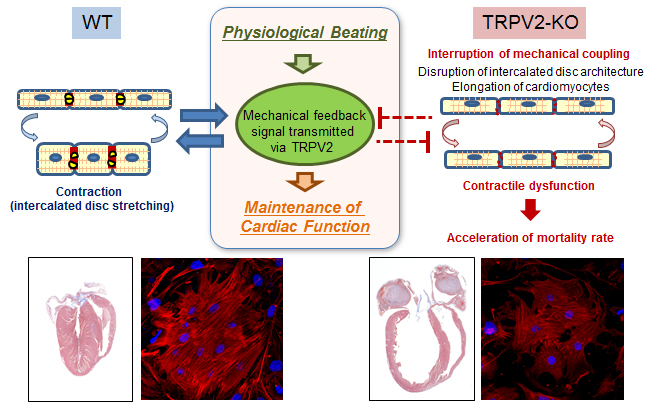Okayama University Medical Research Updates (OU-MRU) Vol.4
December 25, 2014
Source: Okayama University (JAPAN), Center for Public Information
For immediate release:
Okayama University research: cardiac mechanosensitive integrator
(Okayama, 22 December 2014) Researchers at Okayama University Graduate School of Medicine and co-workers across Japan have uncovered the crucial role played by a particular protein (TRPV2) in maintaining a healthy heart
The heart is a dynamic, finely-tuned mechanical structure which must continually respond to fluctuations in blood flow in the body. Exercise and pregnancy can strengthen the heart, requiring it to improve cardiac muscle power and pumping ability. Prolonged bed rest and lack of exercise leads to ‘cardiac atrophy’ – the wasting away of muscles, reducing the heart’s ability to pump blood effectively. However, despite the importance of the heart’s responses to mechanical forces, the mechanisms behind healthy cardiac mechanics are not clear.
Now, Yuki Katanosaka and co-workers at Okayama University, together with scientists across Japan, have uncovered the role of a particular protein called TRPV2 in maintaining a healthy, functioning heart1.
TRPV2 is one of a group of proteins known to act as sensors for flow changes and tension in cells. TRPV2 is highly localised in microscopic elements of cardiac muscles known as ‘intercalated discs’, which are responsible for synching heart-muscle contractions. The interaction between intercalated discs and myocytes – the muscle cells which create the electrical impulses that control heart rate - drives the healthy expansion and contraction of the heart.
Katanosaka and her team generated temporally controlled cardiac-specific TRPV2-deficient mice in order to clarify the role of the protein. They found that, within four days of eliminating TRPV2, heart function declined rapidly – coupling between myocytes and intercalated discs was severely disrupted, and the discs became disordered. After nine days, the myocytes displayed problems handling calcium ions, leading to poor cardiac muscle contraction.
The researchers also discovered that TRPV2-deficient neonatal myocytes did not form mature intercalated discs. They believe TRPV2 may have a crucial role co-ordinating the transmission of forces through cardiac muscle.
Background
The mechanical structures in the heart must respond quickly to changes in blood flow and stress in order to maintain healthy, effective cardiac function. Both exercise and pregnancy require the heart to work harder; the mass of the heart increases, heart wall thickness increases and the ability of the heart to pump blood around the body improves. Prolonged bed rest, lack of exercise, and more unusual situations such as weightlessness in zero-gravity, can also lead to thickening of the heart wall, but the cardiac muscles are weakened, and the blood-pumping action is considerably reduced.
The regular expansion and contraction of the heart is controlled by two key features of the heart muscle – muscle cells known as myocytes, and microscopic cell-to-cell junctions unique to cardiac muscles known as ‘intercalated discs’. These discs are coupled with the myocytes at their termini and together form a single functioning unit. Cardiac myocytes create the electrical impulses that control heart rate, and the discs help synch the contraction of cardiac muscle tissue. If the coupling mechanism between these two features is disrupted, the heart fails to function correctly and no longer pumps blood effectively around the body.
Yuki Katanosaka and her team at Okayama University have made a crucial link between the protein TRPV2 and the healthy co-ordination of mechanical forces within heart muscle tissue. The contraction of the heart and subsequent pumping of blood around the body appears to be largely controlled by the presence of TRPV2 in intercalated discs within the muscles. Without TRPV2, heart structure and function rapidly declines.
Reference
Yuki Katanosaka, Keiichiro Iwasaki, Yoshihiro Ujihara, Satomi Takatsu, Koki Nishitsuji, Motoi Kanagawa, Atsushi Sudo, Tatsushi Toda, Kimiaki Katanosaka, Satoshi Mohri, & Keiji Naruse. TRPV2 is critical for the maintenance of cardiac structure and function in mice. Nature Communications (2014)
Abstract URL: http://www.nature.com/ncomms/2014/140529/ncomms4932/full/ncomms4932.html
DOI: 10.1038/ncomms4932

Figure caption: Researchers at Okayama University have uncovered the role of protein TRPV2 in maintaining a healthy, functioning heart in mice models. The protein works to maintain links between muscle cells and cell-to-cell junctions known as intercalated discs, leading to effective expansion and contraction of the heart muscle.
Correspondence to
Assistant Professor Yuki Katanosaka, Ph.D.
Department of Cardiovascular Physiology, Graduate
School of Medicine, Dentistry and Pharmaceutical
Sciences, Okayama University, Shikata-cho 2-5-1,
Okayama city, Okayama 700-8558, Japan
E-mail: ytanigu@md.okayama-u.ac.jp
Further information
Okayama University
1-1-1 Tsushima-naka , Kita-ku , Okayama 700-8530, Japan
Planning and Public Information Division, Okayama University
E-mail: www-adm@adm.okayama-u.ac.jp
Website: //www.okayama-u.ac.jp/index_e.html
Okayama Univ. e-Bulletin://www.okayama-u.ac.jp/user/kouhou/ebulletin/
Okayama University Medical Research Updates (OU-MRU)
Vol.1:Innovative non-invasive ‘liquid biopsy’ method to capture circulating tumor cells from blood samples for genetic testingVol.2:Ensuring a cool recovery from cardiac arrestVol.3:Organ regeneration research leaps forward
About Okayama University
Okayama University is one of the largestcomprehensive universities in Japan with roots going back to the Medical Training Place sponsored by the Lord of Okayama and established in 1870. Now with 1,300 faculty and 14,000 students, the University offers courses in specialties ranging from medicine and pharmacy to humanities and physical sciences. Okayama University is located in the heart of Japan approximately 3 hours west of Tokyo by Shinkansen.